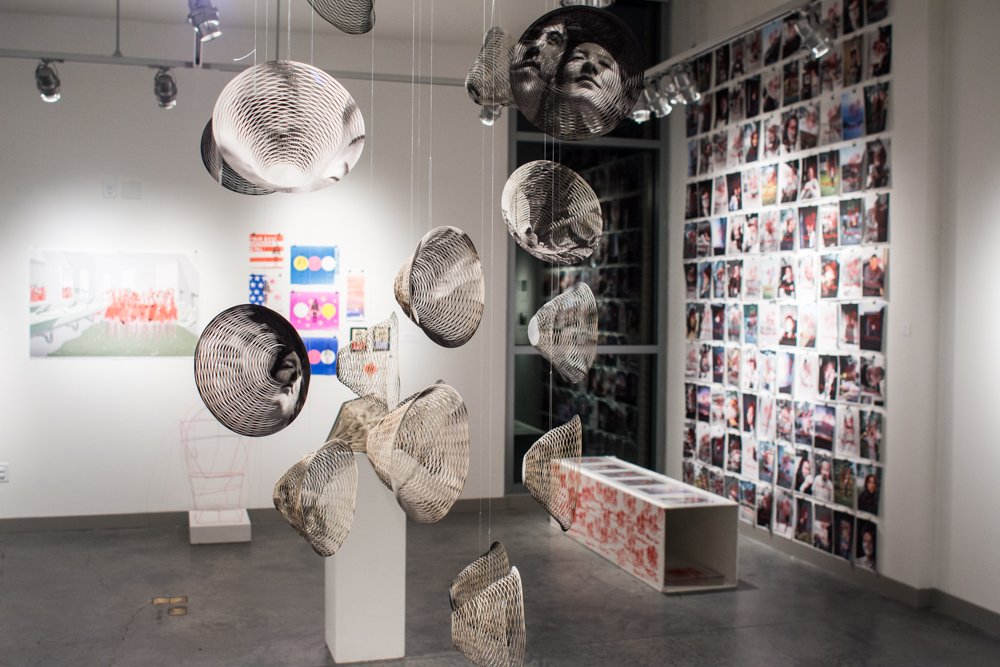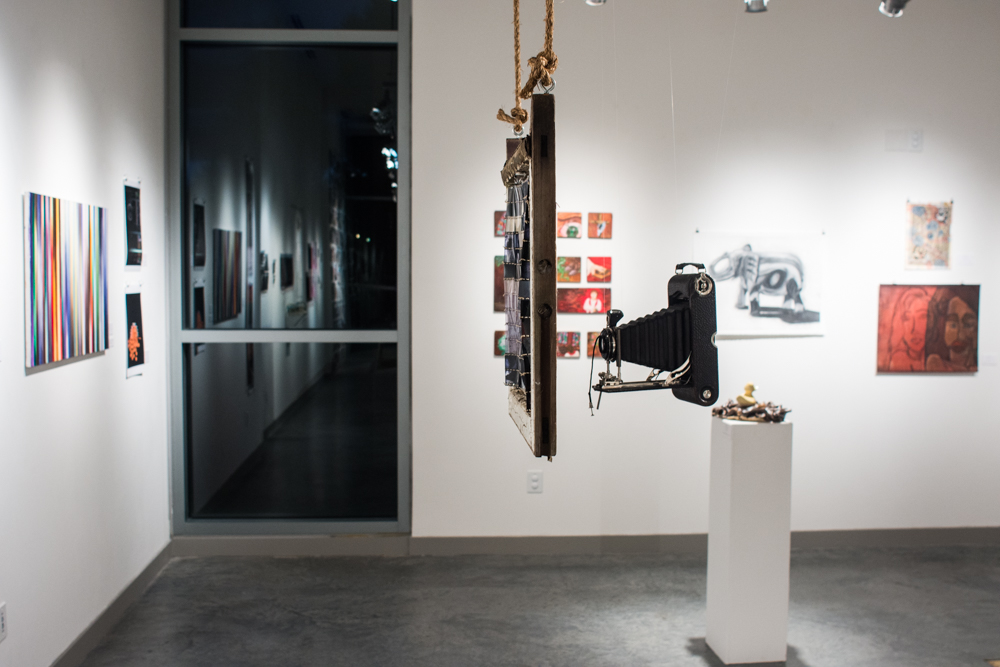Art pieces of all forms now make their temporary home in the gallery space and hallways of Fouts Center for Visual Arts. The eleventh Annual Winter Student Art Salon opened there on January 16 and will continue through February 7. The salon features work by both art majors and non-art majors, who submitted pieces for review just before winter break. A jury of three Whitman art professors—Charly Bloomquist, Rick Martinez and Justin Lincoln—selected pieces to be displayed in the salon.
Art on display ranges from photography and prints to sculptures and paintings, all unique and engaging. Creativity knows no bounds in the studio, and some students took the opportunity to experiment and blend their art across genres and mediums.

Carson Jones
Piece by Anna Dawson ’18. Photo by Carson Jones.
Art major Anna Dawson ’18 considers herself primarily a photographer, but also enjoys playing with paper. Her interest in both mediums resulted in two of her pieces displayed in the salon: “In Between,” a collection of photographs displayed as swirls that hang from the ceiling in the gallery, and “Mom and Dad,” a photograph that has raised ridges, which makes it so that the viewer sees a different face while looking at it from either side.
“I kind of just tried to combine the two [mediums], like how can we look at photographs that are 2D but interact with them as objects or a sculpture, or how can paper represent something more concrete as such a delicate material in comparison to wood or metal sculpture,” Dawson said. “It was kind of an experiment of the two things I’m interested in, and it turned out to be very engaging.”
Dawson also spoke about the meaning behind her piece.
“It’s about how we are the product of two people, at least,” Dawson said. “For me, it’s really clear that it’s about being mixed race–Asian and white–and so for me that’s what it’s about. But for a lot of people, I think it’s just about being the product of two. So if you go to one side you’ll see a picture of my mom, and the other side’s a picture of my dad, and I’m just flat, so it’s kind of supposed to be the lenticular part equals the flat one. But a lot of people seem to like it because you can interact with it by moving around. It’s very logical, kind of like an equation; it makes a lot of sense and can be relatable to a lot of audiences.”
Katina Henderson, who works in the Olin Division Office and took the class Material Translations as a non-traditional student, also took photography in another direction. Her piece, titled “Time Road,” melded together photographs of various roads, starting from a footpath, leading to a wagon road, and traversing various other roads before coming to a photo of Highway 299 in northern California and ending with a time lapse of car taillights turning a corner.
“The prompt for that was to document time passing, and I thought, when it comes to roads, we walk the roads of our ancestors, all the time, all the way back to the ancestors who were just coming out of the ocean,” Henderson said. “[My piece] kept building on the human experience … so it starts out on a footpath and ends up with these red lights, and the time passing there was really amazing to me because it not only spoke about the physicality of the roads themselves, but also where we’ve gone as a species.”
Henderson was glad to have the opportunity to take this art class at Whitman because she feels she has not had the chance to exercise her creativity. Roads, which she explored through her art, also provided her with an opportunity to learn more about herself, as she has spent a lot of time on the road in her life.

Carson Jones
Photo by Carson Jones.
“I did [come to a new understanding], which was a surprise to me,” Henderson said. “I realized I was making roads that traversed time and space and brought me out the other side knowing a little bit more about not just myself, but the world.”
Dawson was also pleasantly surprised in making her pieces that were in the Salon.
“I think it surprised me–the response that I got–because I didn’t know what to expect, because it’s not really a traditional way to present photographs, and I’m not really using photographs in a way that highlights them,” Dawson said. “I think, in a way, it kind of takes away from photographs, the whole entertainment aspect of [‘Mom and Dad’ and ‘In Between’], but I think people like the interaction, and I think people like the glimpse rather than just the straightforward photograph … I think I’m just surprised every day when I do art.”
In addition to the reward of seeing one’s work on display, the Student Art Salon also gives some students the Louis B. Perry Merit Award for pieces that jurors feel are exceptional. Art major Hans Mills ’19 received one of these awards for his piece, “The Ballad of Poor Robert Johnson.”
The piece is a pop-up book detailing the story of Robert Johnson, who trades his soul to the devil in return for the ability to play guitar, in well-crafted images and lyrical language.
“I’d kind of always wanted to do some play on a kid’s book for a long time now,” Mills said. “I came across the story of Robert Johnson, sort of like this mythical story, and it seemed to lend itself pretty well to that format. There’s a couple different morals that you can get from it, which is kid’s book-like, but it’s also simple enough that you can tell it easily.”
Mills also explained part of the inspiration for the aesthetic of his piece.
“In terms of the artwork, there’s an artist called Edward Gorey who did a kid’s book, and it’s sort of similar,” Mills said. “It’s black and white–there are pen drawings, though–and that’s kind of the feel that I wanted to get for those, though.”
The process of making the book took many hours and required many steps, but was worth it in its culmination of a complex piece of art. Furthermore, the Student Art Salon is a great place to exhibit it.
“It’s great because [the Salon] is very accessible,” Mills said. “I’ve never submitted my own artwork for anything and I would be very nervous to do it in any other sort of situation because art’s very personal, so this affords you a place that you feel safe doing that kind of thing.”
Being such a safe space, the Salon is a great opportunity for students who are not art majors to display their pieces. In addition, it simply provides a place where people can see the kind of artwork students are making.
“Ultimately, it really gives me hope when I see these things in there because the people who are creating this art, they’re going to go out and, whatever it is they do with their lives, they’re taking that with them and putting it out there,” Henderson said. “And I haven’t seen anything in there that was dark or awful. Everything’s very interesting, if not hopeful and optimistic, at least intelligent, and that’s really important.”
